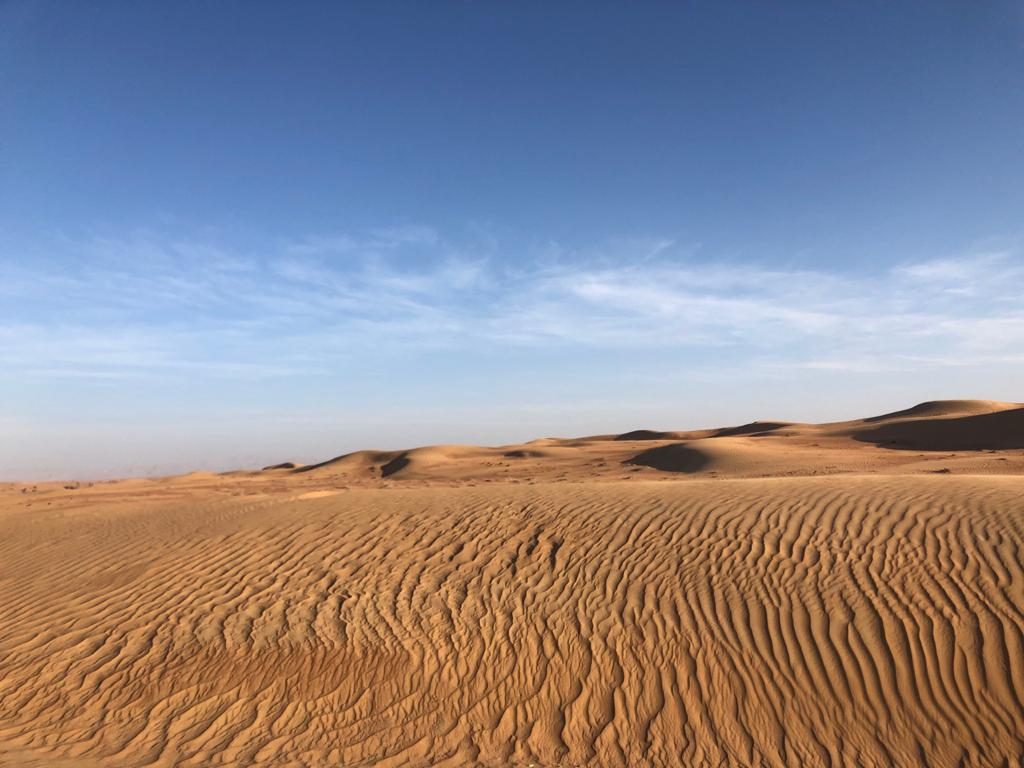Dubai – Burj Khalifa, Burj Al Arab, Dubai Mall, the gold and spice souk. These are go-to spots when it comes to Dubai, since travelers want to go places, even if it’s just to look. And yes, these are great places to see. But if you want to get away from the usual skyscrapers and bling, one option is a desert safari – a tour that honors the tradition of the Arab people and will reward you with unforgettable landscapes and experiences.
At about seven hours, the safari is a bit time-consuming. In other words, if you’re just here for the weekend, this might not be the best way to go. The guides will pick you 3 pm up at the hotel, and you’ll be back around 10 pm. It’s a quick ride; 40 minutes and you’re in the desert, also known as The Empty Quarter, or Rub’al Khali, in Arabic.
The name harks back to the fact that this 650,000-sqm desert spans four countries. It means something like “an empty place split four ways” – the countries are United Arab Emirates, Saudi Arabia, Yemen and Oman. The name also means “empty quarter” in reference to a famously scary and barren desert which has triumphed over kings, adventure-seekers and nomads for thousands of years.
This ANBA reporter went on the Heritage Desert Safari Experience from Platinum Heritage, at the invite of Dubai Tourism, the emirate’s tourism authority. The ride goes for AED 595 (USD 162) at going interest rates.
Once you get there, the guides will invite you to pick a scarf from a basket, with options including yellow, green, black, red, and blue. Men get the traditional white-and-red scheme. The guides will help you tie up your scarf the traditional Bedouin way, covering your hair, and also your face whenever necessary. The desert-dwelling people wore scarves to protect from the sun, the wind and the sand.
And then you ride a 1950s Jeep towards the sand dunes. The vehicle speeds on through so it doesn’t get stuck, and the sun begins to set in this dreamlike landscape, with amazing light, all very “instagramable.”
You get to stop twice to step into the sand, take pictures and shoot videos. It’s striking scenery, you’ll be hard-pressed not to be in awe. Along the way we saw an oasis, some vegetation – there are plants here but no cacti –, and a band of Oryxes, the robust antelopes with long horns that look like unicorns from the side.
And then you get to the falconry demo. The sun sets as you eat canapes and sip alcohol-free champagne made from dates – no booze on this tour. Falcons were great hunting partners for the Bedouin, who’d train the birds of prey to help out with their families’ livelihoods. These days, the tradition is kept alive by the Arab sheikhs, who collect the animals and even join falconry championships.
The falcon in the demo is fed quail imported from France, its caretaker says, due to health reasons. The better the food, the less the chance of disease. For the flight demonstration, it dives down for food. I cue up the camera, but it’s so fast I can’t keep up during the whole flight. In the end, we got to hold the falcon and caress its feathers.
Video: Falcon speed. Bruna Garcia/ANBA
Next up, three camels in a line, squeaky clean, no signs of abuse, freshly bathed – yes, I asked, and they get showered every day. We went for a quick ride and took photos. You also get to hug and caress the camel!
Night comes with the chill of the desert. You’re advised to wear light, loose-fitting clothes, but don’t forget your coat and a scarf for your neck. The temperature plummets in a matter of minutes.
Here we are in the Bedouin campsite, with Arab coffee, henna tattoos and Arab bread, plus the typical fare like camel milk and meat, lentil soup, lamb, rice and chicken, sfiha, Fattoush salad, hummus and baba ghanoush, and even kibbeh. Heartiness galore, and then you get tea, fruit and Arab sweets for dessert.
After the meal you’re offered the shisha, also known as the hookah, as you sit down to a watch a traditional Arab song-and-dance performance. The energy goes through the roof as you’re invited to join in, playing an Eastern-style tambourine. We’re all connected by music and dancing, no matter the language.
Finally, we draw near the bonfire in the cold night, and the guides turn off the camp lights for a few minutes so you can watch the stars. So beautiful, a night-capper. In the end, we had a bit of a first-world problem, which was going back on the topless jeeps. The wind made it even chillier, really cold. But that didn’t last, and it didn’t change anyone’s minds about the ride. Not to be missed!
Watch a video of the ride:
https://www.youtube.com/watch?time_continue=116&v=MaU6elIopgA&feature=emb_title






















